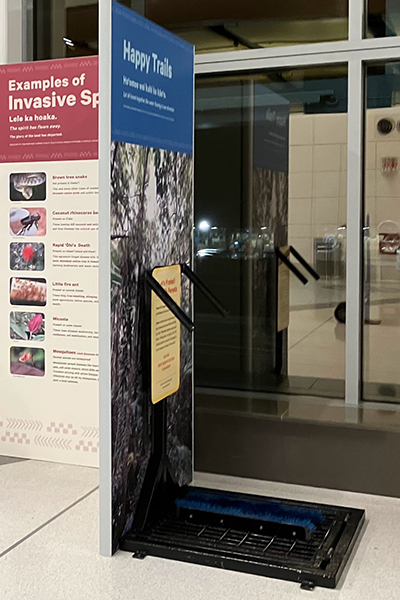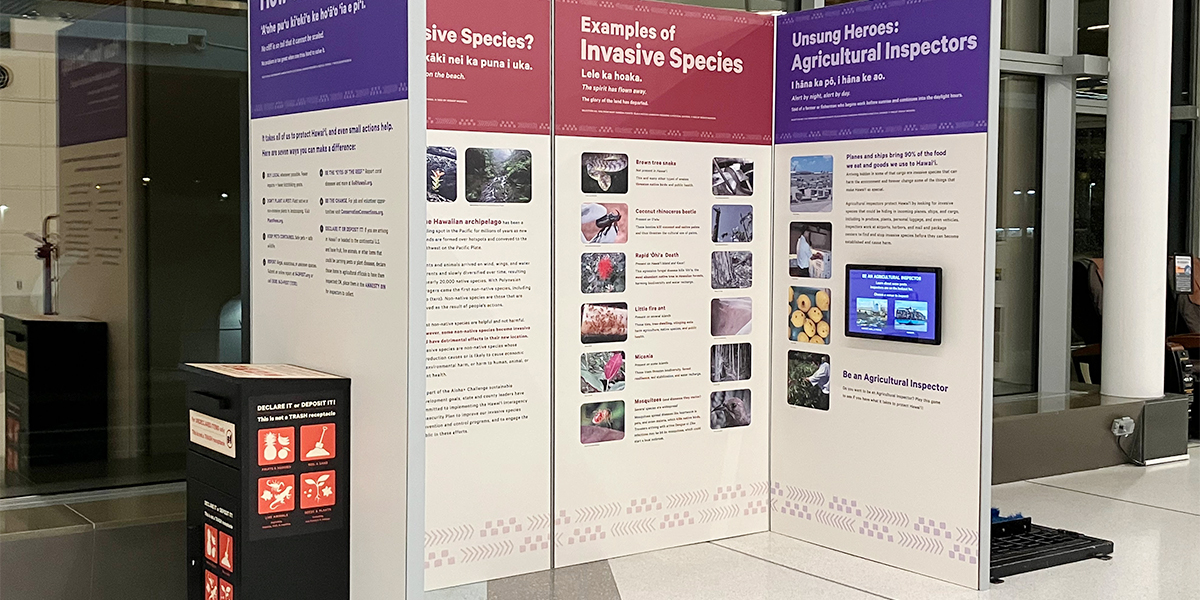A new interactive exhibit at the Daniel K. Inouye International Airport will help to inform travelers about the importance of protecting the state from invasive species and demonstrate some of the actions they can take to make a difference.
The exhibit, spearheaded by the Coordinating Group on Alien Pest Species from the University of Hawaiʻi at Mānoa’s Pacific Cooperative Studies Unit, also features a boot brush station so hikers traveling between islands can remove dirt from their boots, and reduce the spread of invasive weeds and diseases, such as Rapid ʻŌhiʻa Death.
For young travelers, the exhibit has an interactive game called, “Be an Ag Inspector.” Scrolling from screen to screen, keiki and adults can inspect photos of commodities and containers to find the pest, and tap on the screen to win.
“Hopefully people will come away from this display really understanding a little bit more about how they can help protect Hawaiʻi and how precious it is,” said Christy Martin, Coordinating Group on Alien Pest Species program manager.
Hawai‘i residents concerned about invasive species
 A recent survey of Hawai‘i residents showed that 93% of respondents consider invasive species a serious issue. Most of the bad bugs and animals arrive on our shores by air or on a ship. With most of our goods coming from outside the state, airports and harbors are the two primary pathways for pests, which can have negative impacts on agriculture, natural resources and human health.
A recent survey of Hawai‘i residents showed that 93% of respondents consider invasive species a serious issue. Most of the bad bugs and animals arrive on our shores by air or on a ship. With most of our goods coming from outside the state, airports and harbors are the two primary pathways for pests, which can have negative impacts on agriculture, natural resources and human health.
The exhibit is part of the state’s 2017–2027 Hawai‘i Interagency Biosecurity Plan to fill the gaps in invasive species prevention and control, and with the aim to increase awareness in helping to protect Hawai‘i. The new exhibit on the mauka concourse in Terminal 1 was launched at the beginning of February, which is also Hawai‘i Invasive Species Awareness Month.
“It’s colorful, it’s catchy, and it’s interactive,” said Dawn Chang, Chair of the Department of Land and Natural Resources. “It is designed in a way that captures the Hawaiian language. It captures the whole purpose of the biosecurity plan, which is to protect our environment, our food supplies, our homes from invasive species. We see education as one of the first lines of defense for biosecurity.”
Hawai‘i Department of Agriculture Chair Sharon Hurd added, “This exhibit is a great example of the message that we are all responsible for the safe-keeping of Hawai‘i. We’re responsible for keeping our home free of invasive species. It’s like when you invite someone into your home, and you expect them to take their shoes off at the door. That’s why we have the boot cleaning station, so you scrape all the dirt off when you board a plane and when you arrive.”
A team from Bishop Museum designed the biosecurity exhibit, and the content was developed with more than 20 partners.
Funding for the exhibit was provided by the Hawaiʻi Resilience Fund and the Robert Emens Black Fund at the Hawaiʻi Community Foundation. Programmatic support for CGAPS was provided by Hauʻoli Mau Loa Foundation. UH Foundation administered the funds.
UH Mānoa’s Pacific Cooperative Studies Unit is housed in the College of Natural Sciences.
Questions? / More Information
If you would like to learn how you can support UH students and programs like this, please contact us at 808 376-7800 or send us a message.
